
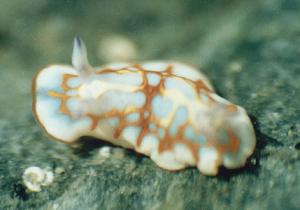
Chromodoris binza
Marcus & Marcus, 1963
Order: NUDIBRANCHIA
Suborder: DORIDINA
Superfamily: EUDORIDOIDEA
Family: Chromodorididae
DISTRIBUTION
Caribbean
PHOTO
UPPER: Havana, Cuba. Photo: Angel Valdes.
LOWER: Santa Marta, Colombia. 8mm long. Photo: Phanor Montoya.
"Both C. clenchi and C. binza have in common an hourglass yellow pattern on the dorsum, which is absent in C. neona. However, C. clenchi has well-defined, rounded and violet dorsal spots, surrounded by thin red lines, whereas C. binza has a much more irregular pattern with a red network of lines surrounding irregular pale blue areas". [From Angel Valdes's message distinguishing these three species].
See Angel Valdes' other message discussing this species and the similarly coloured C. britoi, C. clenchi and C. neona.
See Linda Ianniello's message comparing C. binza and C. clenchi from Florida.
Reference:
• Ortea, J., Valdés, A. & Espinosa, J. (1994) North Atlantic nudibranchs of the Chromodoris clenchi colour group (Opisthobranchia: Chromododorididae). Journal of Molluscan Studies, 60: 237-248.
Rudman, W.B., 2000 (October 9) Chromodoris binza Marcus & Marcus, 1963. [In] Sea Slug Forum. Australian Museum, Sydney. Available from http://www.seaslugforum.net/find/chrobinz
Related messages
Re: Feeding observations on Chromodoris binza
May 19, 2009
From: Linda Ianniello
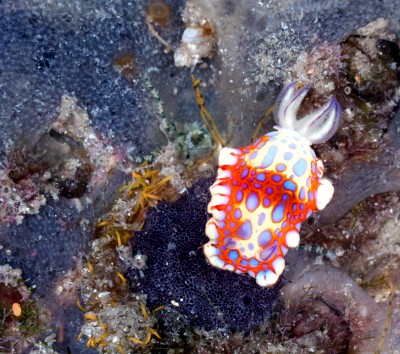
Concerning message #22470:
I was with Anne when she photographed the Chromodoris binza. Attached are the only images I have that show the sponge. Hope they help!
Regards,
Linda
lindai@us.ibm.com
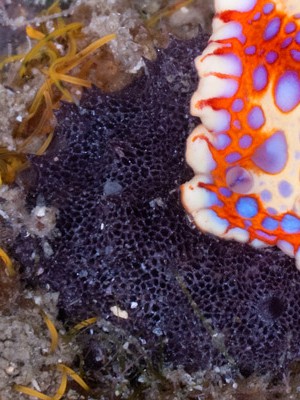


Dear Linda,
Thanks very much. Your photo actually clarifies an 'uncertain feeling' I had with Anne's photos because one purple colony in her photo didn't look quite right. Your photo clearly shows there are two quite unrelated purple sponges living side by side. In your whole photo [top right] you will see that the Chromodoris is on a dark purple sponge with an irregular honeycomb pattern. That is Chelonaplysilla sp., the food of C. binza. Most of the rest of the background is covered with a lighter, almost watery-coloured, purple sponge, which in the close-up [middle right photo] can be seen to have a quite different structure. It has pale tubercles all over from which radiate fibres in a star-like pattern. This is a dysideid sponge, perhaps a species of Dysidea, which coincidentally is the preferred food of species of the related genus Hypselodoris. Interestingly in both Anne's and Linda's photos the C. binza are showing an interest only in the Chelonaplysilla colonies. This is a good example of how easy it is to make a mistake when studying food preferences.
Best wishes,
Bill Rudman
Feeding observations on Chromodoris binza
May 18, 2009
From: Anne DuPont
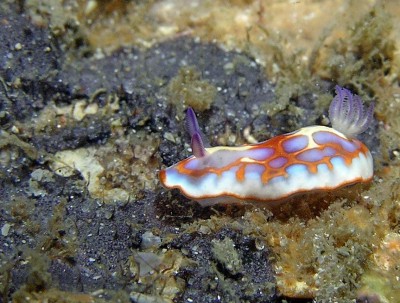
Hello Bill,
I hope you are doing well and are in good health. Here, hopefully, are some more chromodorid feeding photos for you. I observed these two Chromodoris binza which appeared to be feeding on this purple sponge.
Locality details: Lake Worth Lagoon, Palm Beach, Florida, USA.
Atlantic Ocean. Depth: 12 feet. Specimen length: appx 10 mm. 11 June 2008. Photographer: Anne DuPont
Do you think they are feeding and what is the name of the sponge?
Thank you for all the wonderful work you do on the forum.
Cordially,
Anne DuPont
Delray Beach, Fl.
akdupont@bellsouth.net
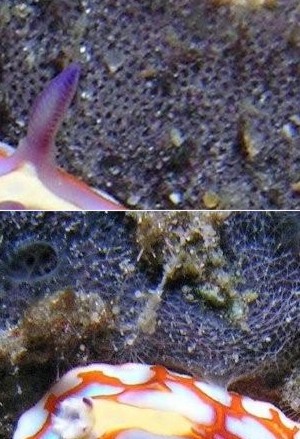
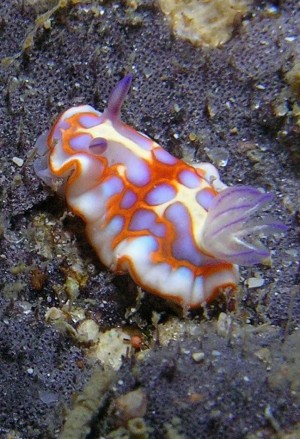

Dear Anne,
Thanks for this great set of photos. There is no doubt in my mind that they are feeding on this purple sponge. More importantly, I am 99% sure it is the same sponge as your Chromodoris clenchi was eating in your message #20835.
I think the sponge is a species of Chelonaplysilla. Interestingly in the Indo-West Pacific Chelonaplysilla violacea is the preferred food of 15 or more chromodorid species most of which have purple in their colour pattern.
Perhaps the purple pigment in these chromodorids is derived from the sponge? If you feel the sponge it has a rough texture, because it
incorporates small sand grains in its tissue.
I will of course need to check the identity of the sponge with an expert. Also of interest is that C. binza and C. clenchi are two of a group of Atlantic species some of which may be forms of one species [see message #3157]. In commenting on that message I said 'It would be interesting to get some information on their food preferences and the shape of their egg masses'. Your two messages are a valuable couple of steps in building up information on these colourful, if problematic, species.
Note added 19 May 2009: The purple sponge in the upper corners of the lower photo [and lower close-up in middle left photo] are a species of Dysidea, which is living alongside the Chelonaplysilla. See Linda Ianniello's message [# 22482] for further photos and discussion.
Best wishes,
Bill Rudman
Material of Chromodoris binza from Caribbean Sea
April 1, 2006
From: Vinicius Padula
Dear Bill,
I need some specimens of Chromodoris binza Marcus & Marcus, 1963 from the Caribbean Sea. It´s to compare with some specimens of Chromodoris cf. neona from southwest Brazilian coast. I have seen the work of Ortea et al.(1994) but I have some doubt about the division of C. binza and C. neona.
If anyone can help me, I will be grateful.
Vinicius Padula
viniciuspadula@yahoo.com
Padula, V., 2006 (Apr 1) Material of Chromodoris binza from Caribbean Sea. [Message in] Sea Slug Forum. Australian Museum, Sydney. Available from http://www.seaslugforum.net/find/16214Dear Vinicius
From looking at the Fact Sheets and messages on C. binza, C. neona etc., the big question is just what is C. binza? Do you want anything that looks like this group of species?
Cheers
Bill Rudman
Venezuelan Chromodoris binza
August 11, 2003
From: Nelsy Rivero
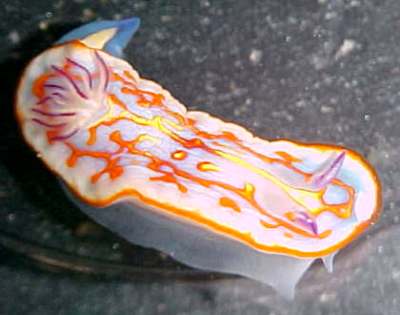
Hi Dr. Rudman
This nudibranch was collected under rocks from Parque Nacional Morrocoy, Venezuela. I think is Chromodoris binza, because is very similar to the picture in Angel Valdes's message. The animal 0.5 cm long.
I would like to obtained more information about this species.
Thank very much,
Nelsy
nelsyrivero@cantv.net
Rivero, N., 2003 (Aug 11) Venezuelan Chromodoris binza. [Message in] Sea Slug Forum. Australian Museum, Sydney. Available from http://www.seaslugforum.net/find/10702Dear Nelsy,
We know very little about Chromodoris binza and Chromodoris clenchi. In an earlier message, Angel Valdes seems quite convinced that C. clenchi and C. binza have quite different colour patterns and behaviour, but if you look at the photos of these two species on the Forum there do appear to be some intermediate colour patterns. As I have said about other problematic species, I think we will only resolve these identification problems when local biologists, study local populations, and compare the feeding and breeding biology, and interactions of the different colour forms. One start would be to photograph the sponge food and egg ribbon of the different colour 'forms'
Best wishes,
Bill Rudman
Re: Photos of Chromodoris clenchi
October 15, 2000
From: Angel Valdes
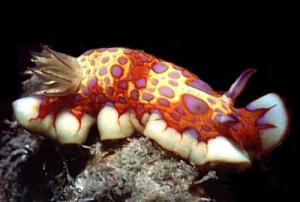
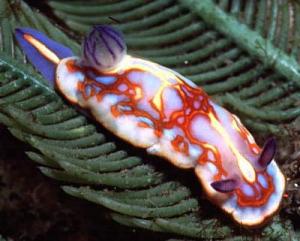
Dear Bill and Dave,
The animal in the upper photo of Dave's message is Chromodoris clenchi, but the animal in the lower photo is Chromodoris binza. [see copies of photos on right] I collected specimens of many different sizes in Cuba and the color pattern is very consistent. In the paper by Ortea et al. (1994) there is a diagram of the ontogenetic variability of the color in these two species (Bill, may be you could scan it and post it in the Forum). Both species have in common an hourglass yellow pattern on the dorsum, which is absent in C. neona. However, C. clenchi has well-defined, rounded and violet dorsal spots, surrounded by thin red lines, whereas C. binza has a much more irregular pattern with a red network of lines surrounding irregular pale blue areas. The two animals in the photos sent by Dave seem to be adults, their color pattern is very complex.
All the best,
Angel
avaldes@calacademy.org
Valdes, A., 2000 (Oct 15) Re: Photos of Chromodoris clenchi. [Message in] Sea Slug Forum. Australian Museum, Sydney. Available from http://www.seaslugforum.net/find/3176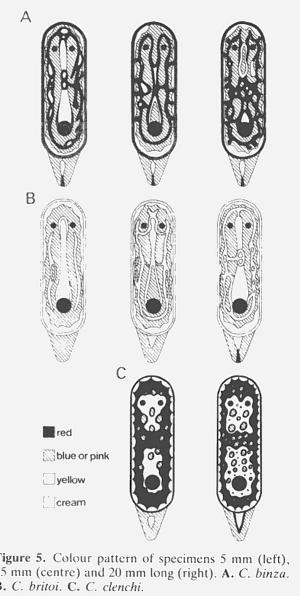
Dear Angel,
Thanks for the clarification. With all the misidentifications in the literature I have found it all a bit comfusing. I have added here smaller copies of Jeff Hamann's photos from Dave's message and have scanned, as you suggest, the comparative diagram (Fig 5) from Ortea et al. (1994).
References: Ortea, J., Valdés, A. & Espinosa, J. 1994. North Atlantic nudibranchs of the Chromodoris clenchi colour group (Opisthobranchia: Chromododorididae). Journal of Molluscan Studies, 60: 237-248.
Best wishes,
Bill Rudman.
Colombian Chromodoris clenchi is C. binza
October 11, 2000
From: Angel Valdes
Dear Bill and Phanor,
I think this animal belongs to the species Chromodoris binza Marcus & Marcus, 1963. There is a paper by Ortea at al. (1994) discussing the differences between the Chromodoris clenchi species complex. According to that paper Chromodoris clenchi (Russell, 1935), Chromodoris neona (Marcus, 1955), Chromodoris binza Marcus & Marcus, 1963 and Chromodoris britoi Ortea & Pérez, 1983 are different species. I am not longer in agreement with all the conclusions of that paper, and I doubt that Chromodoris binza from the Caribbean and Chromodoris britoi from the Mediterranean and Eastern Atlantic are actually distinct. But I am positive that Chromodoris clenchi, Chromodoris neona and Chromodoris binza are different species. I collected extensively Chromodoris clenchi, and Chromodoris binza in the Caribbean, and they differ in color pattern and behavior. There are also some anatomical differences. Chromodoris neona appears to live only in Southern Brazil, and the records of this species from the Caribbean are probably misidentifications.
Reference: Ortea, J., Valdés, A. & Espinosa, J. 1994. North Atlantic nudibranchs of the Chromodoris clenchi colour group (Opisthobranchia: Chromododorididae). Journal of Molluscan Studies, 60: 237-248.
All the best,
Angel
avaldes@calacademy.org
Valdes, A., 2000 (Oct 11) Colombian Chromodoris clenchi is C. binza. [Message in] Sea Slug Forum. Australian Museum, Sydney. Available from http://www.seaslugforum.net/find/3157Dear Angel,
Thanks for this clarification and for drawing my attention to a hole in my reference database. I completely missed your paper when answering Phanor's message. These are an interesting (and beautiful) group of similarly coloured species. It would be interesting to get some information on their food preferences and the shape of their egg masses.
Thanks also for the photos of the different species which I will add in the next couple of days.
Best wishes,
Bill Rudman.
Chromodoris clenchi from Colombia
October 10, 2000
From: Phanor Montoya

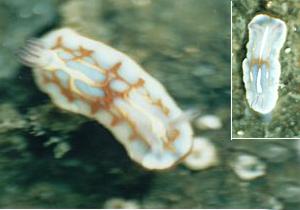
Dear Bill:
This nudibranch was also collected under rocks from Santa Marta, Colombia. I'm sending you photos of what I think are a juvenile and an adult of Chromodoris clenchi or C. neona. The body is white or bluish with a middle straight white line. They also have a kind of orange net that grows as the animal increase in size. The rinophores and gills have internally a violet color. The animals were 2-8 mm long.
I hope you can help me say if they are C. clenchi or C. neona.
Thanks again.
Phanor Montoya.
phamont@eudoramail.com
Montoya, P., 2000 (Oct 10) Chromodoris clenchi from Colombia. [Message in] Sea Slug Forum. Australian Museum, Sydney. Available from http://www.seaslugforum.net/find/3127Dear Phanor,
I have never seen this species alive but from the literature I thin you are right in identifying it as C. clenchi. Most authors consider C. neona and C. britoi are synonyms of this very variable species. The colour form in your photod is particularly beautiful. Almost as though the reticulate pattern was made of gold leaf.
Best wishes,
Bill Rudman.
